




Changes in the characteristic of dietary and lifestyle during Covid-19 lockdown in different countries: A systematic review
Cambios en las características de la dieta y el estilo de vida durante el confinamiento por la Covid-19 en diferentes países: Una revisión sistemática
Jiaxin Li
Changes in the characteristic of dietary and lifestyle during Covid-19 lockdown in different countries: A systematic review
Cultura, Ciencia y Deporte, vol. 18, no. 56, 2023
Universidad Católica San Antonio de Murcia
Jiaxin Li * jiaxin.li@alumnos.upm.es
Facultad de Ciencias de la Actividad Física y del Deporte (INEF), Universidad Politécnica de Madrid, Madrid, Spain
Received: 03 june 2022
Accepted: 11 january 2023
Abstract: Due to the covid-19 pandemic, governments were forced to adopt lockdown policies to effectively control the pandemic. These restrictions increased anxiety, depression, and lifestyle changes. This systematic review aims to analyze changes in dietary patterns in the worldwide population during the COVID-19 lockdown. 11 studies were selected from the 1412 founds after searching in three databases. Searching keywords were: “Change dietary”, “COVID-19 dietary” “Confinement dietary”. Inclusion criteria were: studies that collected people's dietary patterns during the COVID-19 lockdown and recorded the consumption of food groups and the variations in lifestyle habits. This research found that people increased their consumption of food. People increased their sedentary hours, slept more but exercised less, leading to gain weight during the lockdown, as well as a poorer sleeping quality and higher anxiety levels.
Keywords: COVID-19 confinement, food consumption, dietary lockdown lifestyle.
Resumen:
Debido a la pandemia de COVID-19, los gobiernos se vieron obligados a tomar medidas de confinamiento para controlar eficazmente el contagio. Sin embargo, después de un tiempo de control al poblado, estas restricciones hicieron la gente tener más ansiedad y depresión, incluso cambiar el estilo de vida. Esta revisión sistemática tiene un objetivo analizar los cambios dietéticos de la población mundial durante la confinamiento de COVID-19. Se selecciono 11 artículos académicos de los 1412 encontrados tras la búsqueda en tres bases de datos. Las palabras clave de búsqueda fueron: "Cambio dietético", "Dieta COVID-19" "Dieta de confinamiento". Los criterios inclusivos incluyen: estudios que recogieran los patrones dietéticos de las personas durante la confinamiento de COVID-19 y estudios que registran el consumo de las principales categorías de alimentos y las variedades en los hábitos cotidianos. Sobre todo, esta investigación descubrió que, por un lado, se aumentaron el consumo de alimentos, también horas de sentarse y tumbarse, pero curiosamente, con muy pocas horas de hacer ejercicios. Al final, les llevaron a ganar más peso con todo esto durante el confinamiento. Por otro lado, aunque durmieron bastante, pero con mala calidad de sueño por parte de ansiedad, nervios y bajo estado de ánimo.
Palabras clave: confinamiento por COVID-19, consumo de comida, dietético.
Introduction
The COVID-19 virus was first found in 2019, with its transmission all over the world in little time, most countries set up limitations on “quarantine” (Parmet & Sinha, 2020). On January 30, 2020, the World Health Organization (WHO) declared COVID-19 as a global pandemic (Coronavirus Disease (COVID-19) Pandemic, n.d.). At that time, lots of countries began to close their borderlines and impose universal lockdowns to try to stop the spread of COVID-19 (Enriquez-Martinez et al., 2021). The protocols adopted by each country were different, being that social distancing and house confinement were the most used methods. During confinement, civilian mobility was extremely reduced. With that time, more people had limited activities at the home, so some lifestyles changed. This exceptional situation resulted in lifestyle modifications, such as home working (Belzunegui-Eraso & Erro-Garcés, 2020), online school (Daniel, 2020), social distance, and isolation (Thu et al., 2020). In some articles review about the negative psychological impacts (Mattioli et al., 2020). Some people got deep anxiety that makes them eat more junk food and gain weight (Brooks et al., 2020; Jeong et al., 2016) . While data suggests that these interventions had different degrees of success in reducing the transmission of the virus, clinical results have shown many important confounding variables and comorbidities associated with confinement (Teslya et al., 2020). Due to this extraordinary situation, changes in everyday activities, fear, high-stress levels, and lots of free time, emotional eating seemed to increase (Montemurro, 2020), especially in those counties where the lockdown was severe. Therefore, dietary patterns changed either, because of the isolation or the deterioration of health depending on the confinement time (Sepúlveda-Loyola et al., 2020). During that time, some concepts experienced a rise in the public interest. Two key terms, "diet" and "fitness," saw an indication of impairment (McCarthy & McGoldrick, 2021). Some studies investigated lifestyles, sleeping, and dietary changes (Górnicka et al., 2020), some focused on the effect on young people and children (Xiang et al., 2020), some pay attention to the Iberia-American Countries (Enriquez-Martinez et al., 2021) and single European country (Antunes et al., 2020; Di Renzo et al., 2020; Górnicka et al., 2020). In the meantime, the professional sports players had the effect of their training with the mask (“El uso de mascarilla en el deporte,” 2021).
Global vaccination is now being carried out at a high rate. Nevertheless, the COVID-19 virus is still considered a high risk as new waves are coming. Although strict confinement was released in most countries, normality has not been restored worldwide. The questions that remain unanswered are: Are the lifestyle modifications that were settled down during the lockdown permanent? How are these modifications affecting population health (physical and mental) worldwide? And is it true that people's diets deteriorate during lockdown periods in countries with high rates of confirmed COVID-19. To respond to these questions, a systematic review was conducted of the published literature that studied the modifications in dietary and lifestyle patterns and their relationship to health status in different countries during the period of a strict confinement. The purpose of this review is to analyze the literature on the effect of lockdown on lifestyle modifications in 11 countries. The aims are to comprehend the dietary and lifestyle changes that occurred during the initial lockdown. During the initial COVID-19 lockdown phase, it will be determined how such modifications may alter diet and behavior in the short term, and this will then feed study into the longer term effects of diet changes and health consequences.
Method
This systematic review showed the existing literature about people's dietary and lifestyle changes in lockdown time. This review followed the “Preferred Reporting Items for Systematic Reviews and Meta-Analyses (PRISMA) 2020” guideline (http://www.prismastatement.org/PRISMAStatement/CitingAndUsingPRISMA). Additionally, a PRISMA flow diagram of the search process is included (Figure 1).
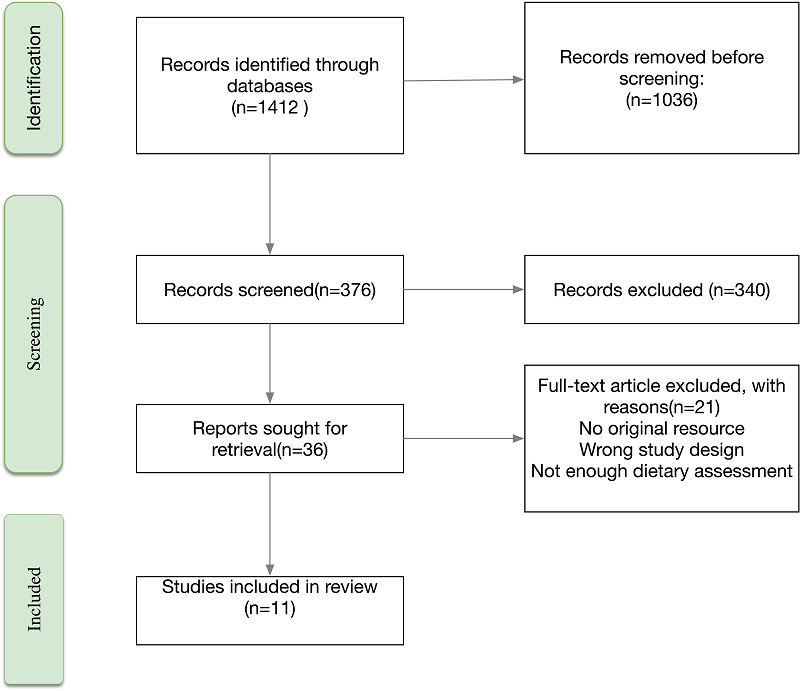
Figure 1
Search process
Searching protocol
This study applied 3 electronic databases, Web of Science; Medline (PubMed), and Google Scholar. These three platforms also included other resources. All three databases are of excellent quality and dependability, ensuring adequate bibliographic assistance. The search spans articles published between January 30, 2020, and Jun 30, 2021. The search phrases in the three databases were a combination of medical topic titles and keywords relevant to Covid-19 dietary and lockdown occur in both the title and the abstract.
Inclusion criteria: Studies on “change dietary” “covid-19 dietary” “confinement dietary” or “lockdown dietary”. Searching without language restriction contained research as well as other related reviews. 1 basic information from the research (study design, sample size, country, diet assessment techniques, and consumption estimation); 2 summaries of results of the nutritional survey (changes in body weight, carbohydrate intake, junk foods, dressing fats, protein sources, snacks, as well as alcohol intake). Carbohydrate intake data was subdivided into four subgroups based on important criteria (snack fast/junk food and sweet food, fruit, vegetables, and cereals). Similarly, we classified the item bodyweight" as "gain," "loss," or "none" depending on whether any change in body weight happened during the lockdown time. The consistency of reported items used to evaluate eating habits across selected studies was determined. Exclusion studies: the article category of technical reports, letters to the editor, micronutrients of dietary.
Risk of bias
The risk of bias in the 11 included publications was assessed using the Cochrane domain-based assessment guidelines (https://www.cochrane.org/news/new-cochrane-handbook-systematic-reviews-interventions, 2021). Each study has three degrees of bias risk: High risk of bias. When the authors did not identify the item or provide any information; a medium risk of bias (marked as one in the general score) when imprecise or partial information was supplied. Two figures will show the results below. Two researchers rated and scored the papers. When a criterion's score differed across publications, a third researcher determined the final score. Two investigators (O.L and J.L) individually searched for publications, evaluated titles and abstracts, read full-texts, and chose items for inclusion. According to the calculation of R, all 11 articles can be considered as a low risk of bias.
Statistical analysis
All the statistical analyses were performed using Excel, version 16.47.1 for Mac (Microsoft. 2021) and R version 4.0.3 under the frontend RStudio 1.4.1103. The part of the Cochrane ROB table using package “obvious” in Figure 2.
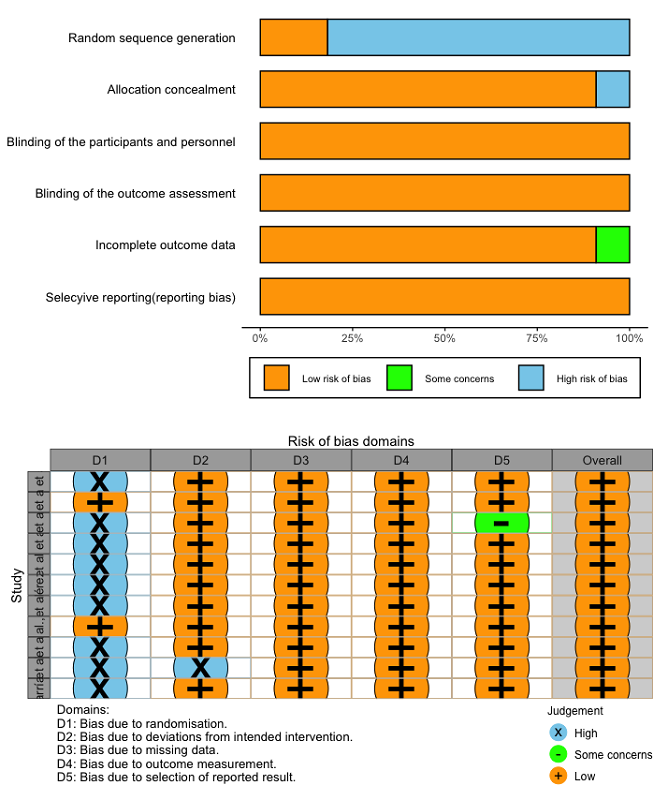
Figure 2
Results of Cochrane ROB
Results
The Overview
The objective of this systematic review was to identify the dietary and other lifestyle changes that occurred during the covid-19 lockdown in different countries. 11 studies were selected from different countries. There were from Poland (Górnicka et al., 2020), Qatar (Ben Hassen et al., 2020), Kuwait (Husain & Ashkanani, 2020), Portuguese (Antunes et al., 2020), Turkey (Kaya et al., 2021), Spain (Rodríguez-Pérez et al., 2020), Italy (Di Renzo et al., 2020), China (Xu et al., 2020), United Kingdom (Ingram et al., 2020), India (Ghosh et al., 2020), and Chile (Reyes-Olavarría et al., 2020). The descriptive data from the 11 studies are shown in Table 1. A total of 40546 subjects were included in this systematic review. The age of participant was between 12 and 72 years. Only one study focused on patients with type 2 diabetes. All the studies but one used an online questionnaire to collect the information. The other way was via telephone interview. Data were collected between March and June 2020. Four of the 11 studies were longitudinal designs while the other 7 studies were cross-sectional. The changes observed in diet and other lifestyles during the studied period are shown in Table 2. We found that most people changed their lifestyles during Covid-19. More people cooked at home, they preferred to avoid eating outdoors. Carbohydrates (fruits, vegetables, grain products), chips, fast meals, sweet foods (cookies, chocolates, homemade pasties...), and milk products (milk, yogurt) are also the main foods consumed. Any reports have not shown the full results. The improvement in body weight was seen in four of the studies. The comprehensive food intake segment is subdivided into Table 3 and Table 4, and Table 5 reflects the emotional change, frequency of physical exercise, sleep, and screen time. The percentages used are derived from the data applied in each article to show the change in impact during the lockdown.
Study detail
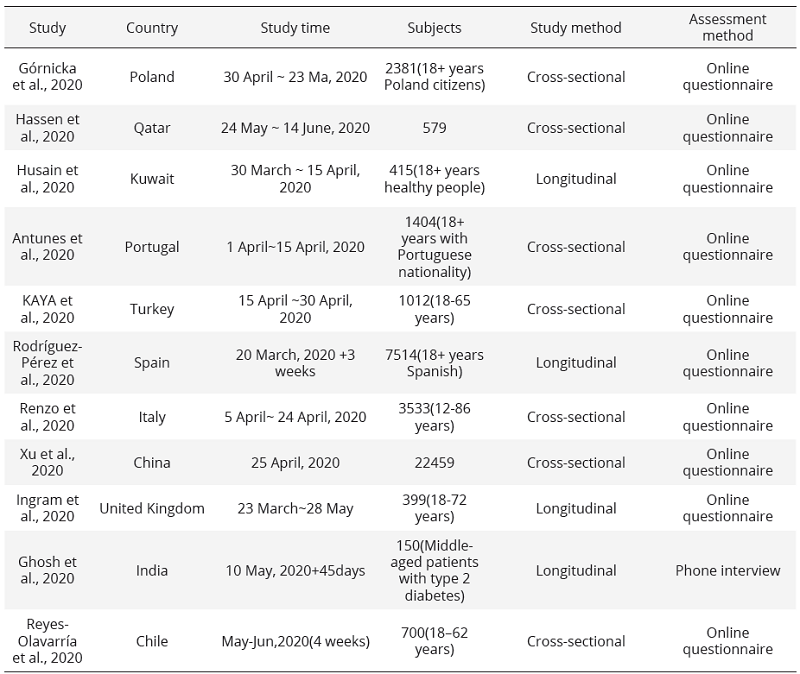
Overall findings
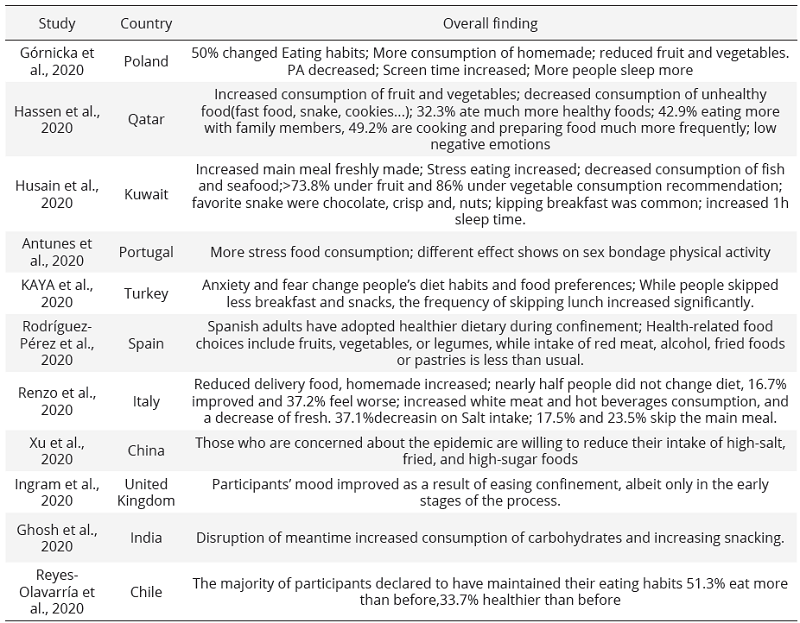
The character of food group pattern
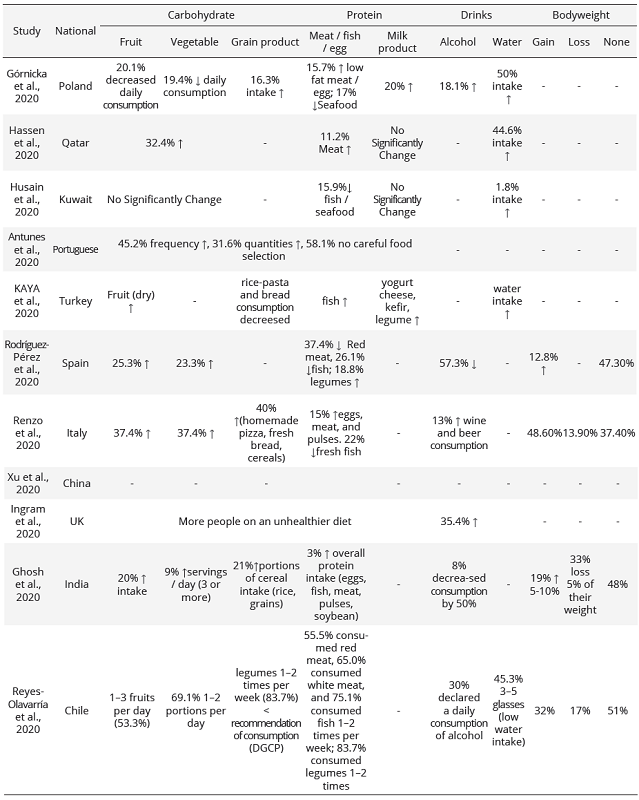
Changes of Food proportion in 11 articles

Food group patterns
According to Table 3 and Table 4, after these 11 countries were reviewed, up to 54.5% of the consumption of Fruit increased during Covid-19 confinement, and vegetables 45.5% increased. But Poland was the opposite (20.1% decreased daily consumption of Fruit, 19.4% decreased daily consumption of vegetables). In Kuwait, >73.8% consumption of fruit and vegetable is recommended no matter before or during Covid-19. For the Grain products, bread, rice, and cereals increased intake on daily/weekly frequency. 3 studies of 11 from Spain, Kuwait, and India using Longitudinal could be more precise to indicate the difference between before and during quarantine. In India, 21% increased cereals intake (rice, grains). In these 3 countries, there was no significant difference among participants in terms of the weekly frequency of consumption of red meat, chicken, processed meat, canned fish, fruits, vegetables, bread, milk, cooking fat, and most snack foods, both before and during the pandemic. In terms of protein intake, people have increased protein intake in all countries, though beef, eggs, and dairy products are still the first option for people to substitute protein in all countries, while consumption of seafood products, such as fish, has lessened considerably in various countries. Among them, Spain had a 26.1% decline in fish intake relative to before. There was 22% of deregistered fresh fish in Italy and there was a 17% decline in Poland. There was a 20% increase in milk products in Poland. Found Turkey that the higher the fear level, the higher the consumption of increased yogurt, cheese, and kefir, while people with high anxiety scores will increase the intake of cheese, and legumes, the higher the fear score, the more consistent statistics on the improvement of milk products. While other countries do not have clear data on changes in dairy products.
Drinks (Alcohol and Water)
Of those 11 countries, the UK had the highest increase in Drinks (Alcohol and Water), with an increase of 35.4%, and Poland had an increase of 18.1% from Table 3. In contrast, there was a 13% decrease in wine and beer consumption in Italy and a 57.3% drop in alcohol intake in Spain, the highest decrease in all 11 countries. However, all other countries saw a small decrease. There have been substantial rises in per capita water intake in Turkey and Qatar, that two countries with no alcohol data statistics because of religion, with 44.6% of people in Qatar increasing their consumption of water. In Turkey, where data related shifts in the consumption of water to mood, the survey showed that the higher the fear score, the higher their consumption of water. 50% increased their water intake in Poland.
Fast/Junk food, Sweet food
Changes of Fast food proportion in 11 articles

From Table 5 and Table 6, we can see that nearly half of the 11 articles (45.5%) show people a willingness to reduce junk food intake. With 44.5% of people in Qatar reporting a reduction in junk food intake and 46% of people in China reporting a desire to reduce their intake of fried food. In Poland, 36.3% reduced, in Italy, 52.9% decreased and in Kuwait, 33% reduced. In terms of junk food consumption, fried foods are the most popular. However, many participants said their intake of fried foods would not be affected by the pandemic, with 73% in Spain and only 37% choosing to reduce their intake to once a week. In China, 40% still eat fried food 4-6/week, and in Chile, data show that eating junk food and fried foods 1-2 times per week is 62.9% and 59.9% during the quarantine. More individuals prefer to bake their sweets at home.
Junk/Fast food, Sweet food, and Snack
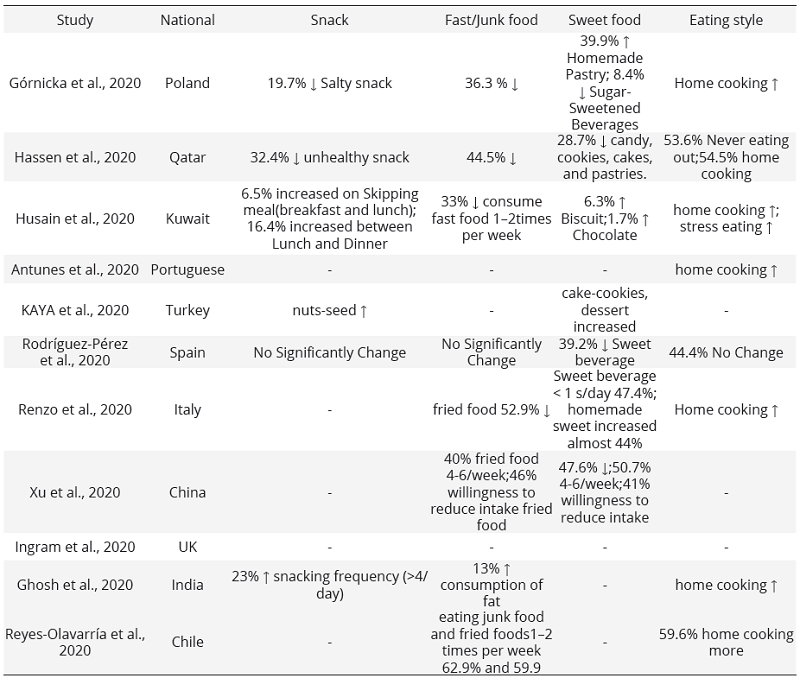
Changes proportion in 11 articles

Physical activity, Screen time and Sleep
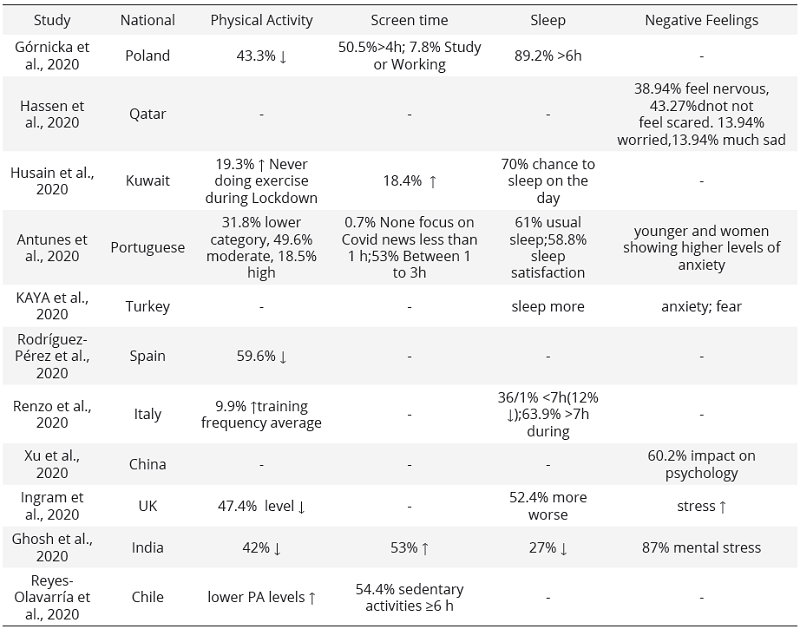
Bodyweight
There were four countries with clear weight change records, Spain had 12.8% of individuals losing weight, 47.3% of weight stays the same, Italy had more individuals gaining weight, 48.6% said they had added weight, Chile had 32%. In India, weight loss of 33% lost 5% of their weight, 19% gained 5-10% more than the individuals who gained weight.
Physical Activity, Sleep, and Emotion
Table 7 and 8 show the influence of physical activity, sleep and emotion. In the UK, 52.4% of people said their standard of sleep decreased during loneliness, and 27% slept less in India, and their anxiety was also very pronounced in both nations, with 87% in India experiencing mental discomfort. During the period of confinement, most people reduced the time spent exercising and also reduced the intensity of exercise. In Spain 59.6% decreased, in India, 42% decreased, and 53% increased screen time. The highest percentage of subjects passed six h sitting, or sedentary behaviors is recorded by Chile (54.4%). Poland found that just 7.8% of the time expended on work and analysis was spent on the rise in screen time.
Discussion
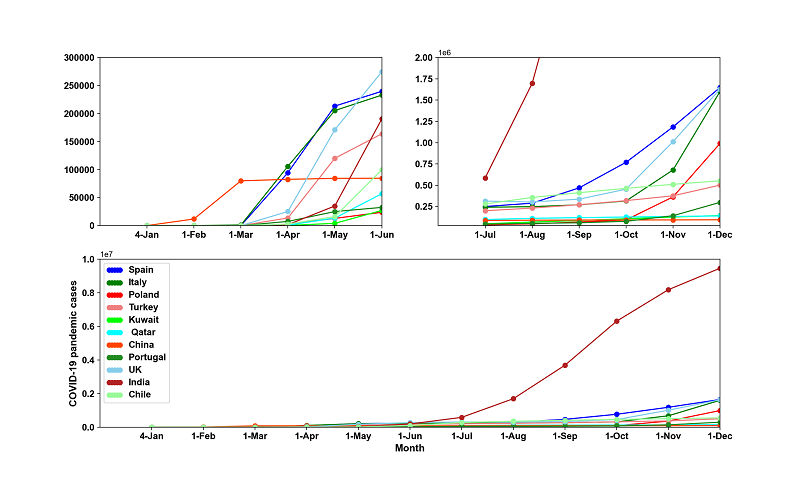
Figure 3
COVID-19 cases
We collected the COVID-19 cases from World Health Organization (WHO) website and made Figure 3 to show the increase in different countries (Coronavirus Disease (COVID-19) Pandemic, n.d.). Over the time of the closure of the Latest Coronavirus epidemic (“COVID-19 Pandemic Cases,” 2020). A systematic review of evidence on people's diets and behaviors in 11 different countries showed that some people's lifestyles had changed greatly, with the intake of fruits, vegetables, cereals, and milk items growing in their diets. Combining the data in the articles review, we found that with the cased increased, and the lockdown in home, more people changed their lifestyle. In countries where the number of cases has grown rapidly, more people's lifestyles became worse like India. The pandemic outbreak was immediately followed by an increase in meat and fish purchases. More people prefer chicken, beef and other low-fat fresh meat, however, fish and other seafood products, a weakening pattern, the outbreak of the latest coronavirus in the Wuhan South China seafood market could be affected by foreign media, resulting in people's fear of reducing consumption of seafood products. Furthermore, the other reason for this decrease can be explained is that the seafood was not available during confinement, the seafood market was closed (Coronavirus Disease (COVID-19) – World Health Organization, n.d., p. 19). People consciously control the intake of junk food, the intake of sweets like cookies, cakes increased, and there is a significant increase in homemade desserts. It may increase the risk of developing obesity (Muscogiuri, n.d.). People like to cook their food one reason is that they were closed at home, for more cooking style, people like to make desserts most of all.
Due to the anxiety caused by the confinement, many people have a significant amount of stress food, people want to eat because of the increased stress, which increases the intake of desserts, and they also gain weight because of the reduced physical activity.
Compared to alcohol, people increase their water intake. Drinking more water is a protective factor that decreased the risk of fat and control hunger (Zheng et al., 2015). Although there is an increase in the consumption of water, water consumption remained under the recommendation (Daniels & Popkin, 2010).In countries where the number of daily illnesses increased dramatically, like India and the UK, people's sleep quality decreased. In both countries, people reported severe negative emotions, compared to other countries where sleep duration became longer and slept quality increased. During the closure period of the pandemic, almost everyone had some stress and negative emotions. In places where the pandemic is well controlled, like Qatar and China, people eat less unhealthy food and become healthier during the epidemic. In contrast, in areas where the epidemic is severe (USA, Mexico, Spain), people tend to eat unhealthy food (unhealthy food means: cookies, candy, and other things that can quickly become fat).
Limitations of this review
This study only studies the lifestyles of different people in 11 countries during the quarantine period. The limitations include cross-sectional studies, small sample sizes, and self-administration of the tests. The sample size of most of the studies analyzed in this paper is not representative and the selected articles only include English articles, and grey literature is also excluded. The review focused only on the lockdown period in the 11 countries, which varied time for each country.
Conclusion
A review of the papers from the 11 countries listed above indicates that nearly half of the people had more anxiety, around one-third of people reduced sleep time, and were erratic in their diet during containment in areas where the pandemic was more severe, opting to consume unhealthy foods that were high in sugar and fat, which was the reason why some people gained weight, and obesity became a risk factor. In the meantime, we should pay less attention to it so that we do not get too stressed and overly worried. We expect to pay more attention to COVID-19. It's also a call to remind people to sustain a balanced diet and lifestyle because of this global pandemic, and that only a healthy body is the most powerful way to help people combat the pandemic.
References
Antunes, R., Frontini, R., Amaro, N., Salvador, R., Matos, R., Morouço, P., & Rebelo-Gonçalves, R. (2020). Exploring Lifestyle Habits, Physical Activity, Anxiety and Basic Psychological Needs in a Sample of Portuguese Adults during COVID-19. International Journal of Environmental Research and Public Health, 17(12), 4360. https://doi.org/10.3390/ijerph17124360
Belzunegui-Eraso, A., & Erro-Garcés, A. (2020). Teleworking in the Context of the Covid-19 Crisis. Sustainability, 12(9), 3662. https://doi.org/10.3390/su12093662
Ben Hassen, T., El Bilali, H., & Allahyari, M. S. (2020). Impact of COVID-19 on Food Behavior and Consumption in Qatar. Sustainability, 12(17), 6973. https://doi.org/10.3390/su12176973
Brooks, S. K., Webster, R. K., Smith, L. E., Woodland, L., Wessely, S., Greenberg, N., & Rubin, G. J. (2020). The psychological impact of quarantine and how to reduce it: Rapid review of the evidence. The Lancet, 395, 10. https://doi.org/10.1016/S0140-6736(20)30460-8
Coronavirus disease (COVID-19) – World Health Organization. (n.d.). Retrieved December 18, 2020, from https://www.who.int/emergencies/diseases/novel-coronavirus-2019
Coronavirus disease (COVID-19) pandemic. (n.d.). Retrieved November 28, 2022, from https://www.who.int/europe/emergencies/situations/covid-19
COVID-19 pandemic cases. (2020). In Wikipedia. https://en.wikipedia.org/w/index.php?title=COVID-19_pandemic_cases&oldid=994544366
Daniel, S. J. (2020). Education and the COVID-19 pandemic. PROSPECTS, 49(1–2), 91–96. https://doi.org/10.1007/s11125-020-09464-3
Daniels, M. C., & Popkin, B. M. (2010). Impact of water intake on energy intake and weight status: A systematic review: Nutrition Reviews©, Vol. 68, No. 9. Nutrition Reviews, 68(9), 505–521. https://doi.org/10.1111/j.1753-4887.2010.00311.x
Di Renzo, L., Gualtieri, P., Pivari, F., Soldati, L., Attinà, A., Cinelli, G., Leggeri, C., Caparello, G., Barrea, L., Scerbo, F., Esposito, E., & De Lorenzo, A. (2020). Eating habits and lifestyle changes during COVID-19 lockdown: An Italian survey. Journal of Translational Medicine, 18(1), 229. https://doi.org/10.1186/s12967-020-02399-5
El uso de mascarilla en el deporte: Una revisión integradora durante la covid-19. (2021). Cultura, Ciencia y Deporte, 16(49). https://doi.org/10.12800/ccd.v16i49.1554
Enriquez-Martinez, O. G., Martins, M. C. T., Pereira, T. S. S., Pacheco, S. O. S., Pacheco, F. J., Lopez, K. V., Huancahuire-Vega, S., Silva, D. A., Mora-Urda, A. I., Rodriguez-Vásquez, M., Montero López, M. P., & Molina, M. C. B. (2021). Diet and Lifestyle Changes During the COVID-19 Pandemic in Ibero-American Countries: Argentina, Brazil, Mexico, Peru, and Spain. Frontiers in Nutrition, 8, 671004. https://doi.org/10.3389/fnut.2021.671004
Ghosh, A., Arora, B., Gupta, R., Anoop, S., & Misra, A. (2020). Effects of nationwide lockdown during COVID-19 epidemic on lifestyle and other medical issues of patients with type 2 diabetes in north India. Diabetes & Metabolic Syndrome: Clinical Research & Reviews, 14(5), 917–920. https://doi.org/10.1016/j.dsx.2020.05.044
Górnicka, M., Drywień, M. E., Zielinska, M. A., & Hamułka, J. (2020). Dietary and Lifestyle Changes During COVID-19 and the Subsequent Lockdowns among Polish Adults: A Cross-Sectional Online Survey PLifeCOVID-19 Study. Nutrients, 12(8), 2324. https://doi.org/10.3390/nu12082324
Husain, W., & Ashkanani, F. (2020). Does COVID-19 change dietary habits and lifestyle behaviours in Kuwait: A community-based cross-sectional study. Environmental Health and Preventive Medicine, 25(1), 61. https://doi.org/10.1186/s12199-020-00901-5
Ingram, J., Maciejewski, G., & Hand, C. J. (2020). Changes in Diet, Sleep, and Physical Activity Are Associated With Differences in Negative Mood During COVID-19 Lockdown. Frontiers in Psychology, 11, 588604. https://doi.org/10.3389/fpsyg.2020.588604
Jeong, H., Yim, H. W., Song, Y.-J., Ki, M., Min, J.-A., Cho, J., & Chae, J.-H. (2016). Mental health status of people isolated due to Middle East Respiratory Syndrome. Epidemiology and Health, 38, e2016048. https://doi.org/10.4178/epih.e2016048
Kaya, S., Uzdil, Z., & Cakiroğlu, F. P. (2021). Evaluation of the effects of fear and anxiety on nutrition during the COVID-19 pandemic in Turkey. Public Health Nutrition, 24(2), 282–289. https://doi.org/10.1017/S1368980020003845
Mattioli, A. V., Ballerini Puviani, M., Nasi, M., & Farinetti, A. (2020). COVID-19 pandemic: The effects of quarantine on cardiovascular risk. European Journal of Clinical Nutrition, 74(6), 852–855. https://doi.org/10.1038/s41430-020-0646-z
McCarthy, A. D., & McGoldrick, D. (2021). Analyzing Public Interest in Metabolic Health-Related Search Terms During COVID-19 Using Google Trends. Cureus. https://doi.org/10.7759/cureus.15715
Montemurro, N. (2020). The emotional impact of COVID-19: From medical staff to common people. Brain, Behavior, and Immunity, 87, 23–24. https://doi.org/10.1016/j.bbi.2020.03.032
Muscogiuri, G. (n.d.). Nutritional recommendations for CoVID-19 quarantine. 2.
Parmet, W. E., & Sinha, M. S. (2020). Covid-19—The Law and Limits of Quarantine. New England Journal of Medicine, 382(15), e28. https://doi.org/10.1056/NEJMp2004211
Reyes-Olavarría, D., Latorre-Román, P. Á., Guzmán-Guzmán, I. P., Jerez-Mayorga, D., Caamaño-Navarrete, F., & Delgado-Floody, P. (2020). Positive and Negative Changes in Food Habits, Physical Activity Patterns, and Weight Status during COVID-19 Confinement: Associated Factors in the Chilean Population. International Journal of Environmental Research and Public Health, 17(15), 5431. https://doi.org/10.3390/ijerph17155431
Rodríguez-Pérez, C., Molina-Montes, E., Verardo, V., Artacho, R., García-Villanova, B., Guerra-Hernández, E. J., & Ruíz-López, M. D. (2020). Changes in Dietary Behaviours during the COVID-19 Outbreak Confinement in the Spanish COVIDiet Study. Nutrients, 12(6), 1730. https://doi.org/10.3390/nu12061730
Sepúlveda-Loyola, W., Rodríguez-Sánchez, I., Pérez-Rodríguez, P., Ganz, F., Torralba, R., Oliveira, D. V., & Rodríguez-Mañas, L. (2020). Impact of Social Isolation Due to COVID-19 on Health in Older People: Mental and Physical Effects and Recommendations. The Journal of Nutrition, Health & Aging, 24(9), 938–947. https://doi.org/10.1007/s12603-020-1500-7
Teslya, A., Pham, T. M., Godijk, N. G., Kretzschmar, M. E., Bootsma, M. C. J., & Rozhnova, G. (2020). Impact of self-imposed prevention measures and short-term government-imposed social distancing on mitigating and delaying a COVID-19 epidemic: A modelling study. PLOS Medicine, 17(7), e1003166. https://doi.org/10.1371/journal.pmed.1003166
Thu, T. P. B., Ngoc, P. N. H., Hai, N. M., & Tuan, L. A. (2020). Effect of the social distancing measures on the spread of COVID-19 in 10 highly infected countries. Science of The Total Environment, 742, 140430. https://doi.org/10.1016/j.scitotenv.2020.140430
Xiang, M., Zhang, Z., & Kuwahara, K. (2020). Impact of COVID-19 pandemic on children and adolescents’ lifestyle behavior larger than expected. Progress in Cardiovascular Diseases, 63(4), 531–532. https://doi.org/10.1016/j.pcad.2020.04.013
Xu, Y., Li, Z., Yu, W., He, X., Ma, Y., Cai, F., Liu, Z., Zhao, R., Wang, D., Guo, Y.-F., & Chen, J. (2020). The association between subjective impact and the willingness to adopt healthy dietary habits after experiencing the outbreak of the 2019 novel coronavirus disease (COVID-19): A cross-sectional study in China. Aging, 12(21), 20968–20981. https://doi.org/10.18632/aging.103929
Zheng, M., Rangan, A., Olsen, N. J., Andersen, L. B., Wedderkopp, N., Kristensen, P., Grøntved, A., Ried-Larsen, M., Lempert, S. M., Allman-Farinelli, M., & Heitmann, B. L. (2015). Substituting sugar-sweetened beverages with water or milk is inversely associated with body fatness development from childhood to adolescence. Nutrition, 31(1), 38–44. https://doi.org/10.1016/j.nut.2014.04.017
Author notes
* Correspondence: Jiaxin Li, jiaxin.li@alumnos.upm.es
Additional information
How to cite this article: Jiaxin, L. (2023). Changes in the characteristic of dietary and lifestyle during Covid-19 lockdown in different countries: A systematic review. Cultura, Ciencia y Deporte, 18(56), 83-93. https://doi.org/10.12800/ccd.v18i56.1916

ISSN: 1696-5043
Vol. 18
Num. 56
Año. 2023
Changes in the characteristic of dietary and lifestyle during Covid-19 lockdown in different countries: A systematic review
Jiaxin Li
Universidad Politécnica de Madrid,Spain


